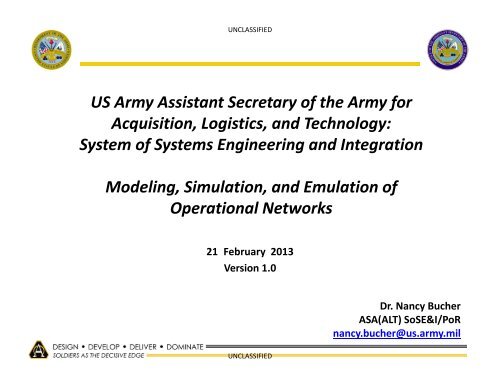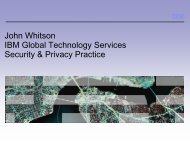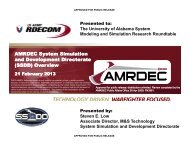Dr. Nancy Bucher ASA(ALT)
Dr. Nancy Bucher ASA(ALT)
Dr. Nancy Bucher ASA(ALT)
- No tags were found...
Create successful ePaper yourself
Turn your PDF publications into a flip-book with our unique Google optimized e-Paper software.
UNCLASSIFIEDUS Army Assistant Secretary of the Army forAcquisition, Logistics, and Technology:System of Systems Engineering and IntegrationModeling, Simulation, and Emulation ofOperational Networks21 February 2013Version 1.0<strong>Dr</strong>. <strong>Nancy</strong> <strong>Bucher</strong><strong>ASA</strong>(<strong>ALT</strong>) SoSE&I/PoRnancy.bucher@us.army.milUNCLASSIFIED
Office of the Assistant Secretary of the Army(Acquisition, Logistics, and Technology)SUPPORT OPERATIONS SYSTEMS ENGINEERING SoSEPOLICY / CIO SYSTEMS INTEGRATION SoSI2
<strong>ASA</strong>(<strong>ALT</strong>) SoSE&I OverviewSUPPORT OPERATIONS SYSTEMS ENGINEERING SoSEPOLICY / CIO SYSTEMS INTEGRATION SoSI3
SoSE&I Mission and VisionMission: Provide coordinated system of systems analysis, engineering, architecturaland integration products to facilitate how the Army efficiently shapes, manages,validates and synchronizes the fielding of integrated materiel capabilitiesVision: To be the focal point for System of Systems Engineering and Integration acrossthe Army’s materiel development and acquisition communitySUPPORT OPERATIONS SYSTEMS ENGINEERING SoSEPOLICY / CIO SYSTEMS INTEGRATION SoSI4
Systems Capability Development Reference FrameworkInter‐AgencyCoalitionJointArmySUPPORT OPERATIONS SYSTEMS ENGINEERING SoSE<strong>ASA</strong>(<strong>ALT</strong>)V5.02 11/02/12POLICY / CIO SYSTEMS INTEGRATION SoSI
UNCLASSIFIEDSoSE&I Modeling &Simulation Team Mission• Per AR 70‐1, (RDA Army Acquisition Policy), all PMs are to incorporateModeling & Simulation (M&S) in their acquisition strategies, as prudent, toreduce cost and accelerate decision cycles in system engineering and test andevaluation activities throughout the acquisition process.• The SoSE&I M&S team works with the PEO/PM, Army, and DoD M&Scommunities to identify:• areas for application of M&S• resident M&S capabilities• potential technical solutions to PM issues• provide assistance in mitigating gaps• The SoSE&I M&S team has established an IPT for PoR representatives to bringtheir M&S issues and concerns, and to solicit assistance in developing andexecuting the program M&S activities.UNCLASSIFIED6
UNCLASSIFIEDExample Applications of Modeling, Simulation,and Analysis Throughout the Lifecycle.Derived from NDIA M&S Subcommittee activitiesUNCLASSIFIED7
SoSE&I Modeling, Simulation, and Emulation ofOperational Networks and Net‐Centric SystemsSUPPORT OPERATIONS SYSTEMS ENGINEERING SoSEPOLICY / CIO SYSTEMS INTEGRATION SoSI8
RELEVANT OPERATIONAL CONTEXT FOR “ALWAYS ON”:The Integrated Battlespace at a Joint and Coalition Level9
Illustration of Airspace Clearance(Joint Fires Air‐to‐Surface Example)4CRC request X-CAS andpriority support from AOC5CRC tasks F-16 to support TICAOC – (JICC)6CRC coordinates with TAOCto clear airspace for TICCRC7TPS-75CRC directs F-16 to ASOC8ASOC directsF-16 to JTACROZDASC-(TAOC)ASOC93JTAC directsF-16 to TICTOC -(ADAM/BAE)21TICTIC occurs, request forimmediate air supportTOC creates a RestrictedOperating Zone over TICTOC requests air support from CRC
REALISTIC RELEVANT OPERATIONAL CONTEXT FOR RDTEON OPERATIONAL NETWORKSEFFECTIVE OPERATIONAL NETWORKS CRITICALLY UNDERPIN ARMY MISSION SUCCESSTHE NETWORK IS THE ARMY’S NUMBER ONE MODERNIZATION PRIORITY11
CURRENT GAP IN M&S AND EMULATION FOROPERATIONAL NETWORKS AND NET‐CENTRIC SYSTEMS‣ Critical Need:‣ Authoritative Persistent Integrated Environment for Analysis, Research,Design, Test, Evaluation, Training and Experimentation on OperationalNetworks‣ Current Situation:‣ Individual efforts being done in stove‐pipe manner provide limited and /orinconsistent data and feedback about Operational Networks, impacting theWarfighter now‣ What is missing:‣ Continuous availability of authoritative Network models, data,representative architectures and metrics for use across the life cycle fromConcept Design to Development, to Test and Evaluation, to Training andMission Rehearsal12
VISION: SYSTEM OF SYSTEMS ENVIRONMENT FOR“ALWAYS ON”“Always On”: Establishing a Continuous Authoritative Network LVC Environment forDevelopment, Test, and Training of Operational Networks & Netcentric Systems:Providing a Common Pedigree of Data Available to All UsersInstrumentationWarfighter SystemsDistributed Common ComponentsDataHPC assets for Continual Capability BasedRDT&E for Network & warfighter systemPerformance, Interoperability, Effectiveness, andSuitabilityUse Cases:Network & System DevelopmentWarfighting ExperimentationTraining & Mission RehearsalOperational PlanningConcept/ Capabilities DevelopmentSupported locally and available remotelyCore Enabling Technologies:Cloud Computing and VirtualizationHigh Performance ComputingMature LVC Tools & EnvironmentsHigh Fidelity ModelsData InteroperabilityRobust connectivity among Armyinstallations13
“ALWAYS ON” ARCHITECTURE CONCEPT:Live‐Virtual‐Constructive Framework That Exists TodayTactical AppsOneSAF, JCATS etcDISTRIBUTED SIMULATIONSVirtual MC/SA Apps etcTENA/HLA/DIS InterfacesC5ISRSensor FeedsLive RadiosSystem in theLoop Interface(HITL/SITL)Tactical NetworkModel LibraryEnterprise NetworkModel LibraryCyberWarfareModelLibraryNetwork Simulator /EmulatorJoint Network Simulator/Emulator EnvironmentNetworkManagementInterface (NMI)OtherApplicationsInterfaceLive NetworkManagerExerciseControl andData Toolsleveraging a set of capabilities that has been developed over the past 15 yearsby a partnership activity between the acquisition, testing, and combatdevelopment communities14
“ALWAYS ON” FOUNDATION OF CAPABILITIESScalable, real‐time, network models with optionsfor fidelity (conceptual, emulation, or abstract)that can be invoked depending on use cases (e.g.SRW, WNW, WIN‐T, etc)Operational Networks test bed environmentcapable of evaluating systems and system ofsystems effectiveness, current & future capabilities,as‐is and to‐be architecturesHigh fidelity RF effects (e.g., urban terrain)System‐in‐the‐loop (“SIL”) with live radios (e.g.GMR, HMS, etc)Software‐in‐the‐loop with live battlefieldapplications (e.g. IBEX, FCBC2, etc)Fast, agile, low risk integration of technology &operations for integration and test events such asNIERepeatable, relevant, end‐to‐end testenvironment capable of executing larger thansingle thread scenariosInterface with live network managers (e.g. JENM)Interface with instrumentation and data collectiontools used on live networks (e.g. OASIS)Interface with external simulation tools (e.g.OneSAF)Representation of Multi‐level SecurityDistributed Networked Live‐Virtual‐Constructivetechnologies environment reducing the need toship equipment and relocate key personnelLeveraging the strengths and tool suites of eachparticipating location, promoting collaboration andreuse of test assets across T&E, Planning, Analysis,Acquisition, Training, CyberRelevant Operational Contexts for TRL assessments15
“ALWAYS ON”: IN LINE WITH THE ARMY T&EENTERPRISE STRATEGIC PLAN 2013LEVERAGE MODELING AND SIMULATION (M&S) TO AUGMENT / REPLACE TESTSAND SHORTEN TESTING16
“ALWAYS ON”: SUPPORTS THE ARMY AGILECAPABILITIES LIFE CYCLE PROCESSFIGURE 1 FROM SOP: AGILE CAPABILITIES LIFE CYCLE PROCESS 7 AUGUST 2012 FINAL v.1OPTIMIZING OPERATIONAL ASSESSMENT OF NEW TECHNOLOGIES VIA NIE17
“ALWAYS ON” LIVE‐VIRTUAL‐CONSTRUCTIVEARCHITECTURETactical AppsOneSAF, JCATS etcDISTRIBUTED SIMULATIONSVirtual MC/SA Apps etcTENA/HLA/DIS InterfacesC5ISRSensor FeedsLive RadiosSystem in theLoop Interface(HITL/SITL)Tactical NetworkModel LibraryEnterprise NetworkModel LibraryCyberWarfareModelLibraryNetwork Simulator /EmulatorJoint Network Simulator/Emulator EnvironmentNetworkManagementInterface (NMI)OtherApplicationsInterfaceLive NetworkManagerExerciseControl andData ToolsPROVIDING A “TEST HARNESS” CAPABILITY WHICH CAN SUPPORT MULTIPLEUSE CASES ACROSS THE ACQUISITION LIFE CYCLE18
“ALWAYS ON” VALUE ADDED TO NIENIE Pre‐Planning and Test Rehearsal:Lab‐based risk reduction for live test events (pre‐screen readiness)Cost reduction for ‘on the ground’ pre‐test activities (e.g network configurations, …)Live NIE Test “Test As We Fight”: Realistic “Network” Relevant Operational Context with increased comms traffic andcomplex live maneuversAssess the impacts of scaling the networksValidate routing and reconfiguration designsAfter Event Review and “What If” Analyses:Assessment of NIE results and lessons learnedTest plan design and refinement for next NIE through lab‐based experimentationNIE PLANNING(TEST REHERSAL)AFTER EVENT REVIEWS(WHAT‐IF ANALYSIS)LIVE NIE TEST(TEST AS WE FIGHT)INTEGRATION AND INTEROPERABILITYEXPERIMENT (I2E)NETWORK INTEGRATION EVALUATION(NIE)ARMY INTEROPERABILITYCERTIFICATION19
“ALWAYS ON” PRIORITIZED USE CASE DETAILS20
“ALWAYS ON” PROGRAM CONCEPT(FY13 to FY19)Full Spectrum Fielded Capability of Joint &Coalition OperationsDistributed Joint and Coalition OpsCoalition RepresentationDistributed Joint OperationsJoint RepresentationDistributed Army FunctionalityAddress High Risk Technologies from Gap AnalysisIncremental Build Approach Leading to Full “Always On” Operational Capability21
“ALWAYS ON” TOP LEVEL SCHEDULEIdentifyFY15‐19POM LineNIE14.1NIE15.1FullyFundedNIE16.2IOCNIE18.1NIE19.2FOCPROTOTYPE• Roadmap Dev• CurrentCapabilities• Focus onCritical Gaps• DetailedRequirements• <strong>Dr</strong>aft ProgramDocuments• DataInteroperabilityMethodologyBASELINE• DistributedArchitecture IOC• ApprovedReqmts B/L• BaselineProgramDocuments• Initial VV&A• DataInteroperabilityTestbedPHASE 1• Refine Requirementsand Architecture• Address CoreTechnology Gaps• Joint Representation• Expand DistributedNetwork Connectivity• Formal Dev Process• Incremental SoSInteroperability Test• Refinement of VV&AProcessPHASE 2• Expanded Capability toAdditional SoS• Distributed NetworkExpanded to AdditionalSites• Distributed JointOperations• Coalition Representation• Initial SoS InteroperabilityTest• Operational C5 TrainingSupportPHASE 3• Architecture SupportsFull SoS Capability• Distributed Network toFull Spectrum of Jointand Coalition• “At Scale” SoSInteroperability Test• Support OperationalTraining• Complete VV&A forNIE 19.2• Continue VV&A Process“Always On”: Establishing a Continuous Authoritative Network LVC Environment forDevelopment, Test, and Training of Operational Networks & Netcentric Systems22
Areas of Modeling and Simulation ResearchIn Support of “Always On”•As a Live‐Virtual‐Constructive development and execution environment, at a system ofsystems level, using distributed network technology, Always On provides a richenvironment for modeling and simulation research and development on OperationalNetworks and Netcentric Systems. Areas include:•Materiel ‐ communication systems and effects, operational and enterprisenetworks, netcentric systems, etc•Operational Realism/Context –blue, red, and grey platform characteristics andinteractive behaviors, etc•Environment –terrain, natural and cultural features, weather, obscurants, etc•Cyber –threat concepts, mitigation concepts, proactive prevention concepts, etc•Interoperability –models, simulations, and live systems characteristics, levels ofdetail, underlying algorithms, behavior representation•Experimentation Architecture – distributed interactive simulation networks, multilevelsecurity technologies, data collection and analysis tools , etc23
MODELING AND SIMULATION RESEARCHCHALLENGE•The Always On system of systems environment and its use in support of research,development, test, evaluation, and experimentation on Operational Networks andNetcentric Systems presents a unique “design of experiments” problem:•Operational realism for mission results validity is critical•Experimental control for data statistical validity is critical•How do we design our test/experiment environment and plan our test procedures toallow for multiple, simultaneous realistic mission tasks to execute as mission eventsunfold, but have sufficient data collection opportunities and control of conditions toallow for statistical validity?•We have been working at this challenge for several years, and we are still learning…•Want to help?24
Back Up Charts25
Data Collection ExampleProximity IssuesDATA:• Clearancesattempted• Clearances grantedSuccessfulClearancesSOURCE:• Chat Logs• Radio Comms• Observation LogsAOC – (JICC)DATA:• Position ofAircraftSOURCE:•COP• ScenarioGeneratorsROZOperator’sUse of COPDATA:• Displayed IDof Aircraft• Actual ID ofAircraftSOURCE:•COP• ScenarioGeneratorsCRCTPS-75ASOCTICTime to ClearAirspaceDASC-(TAOC)AN/TPS-59TOC -(ADAM/BAE)DATA:• Time of Request• Time of AircraftHandover tocontrolling unitSOURCE:• Chat Logs• RadioCommunications• Observation Logs
“ALWAYS ON” PRIORITIZED USE CASES:Guidance from the 18 Oct 12 M&S GOSC1. End‐to‐end Testing of Network‐enabled Hardware, Middleware orApplications in a Realistic and Relevant Operational Context2. Operational Planning and Network Assessment Prior to Deployment;Dynamic Re‐Planning and Assessment in Theater3. Experimentation and Assessment of Network Cyber Threats at Eachof the Five Layers of the Operational Network4. Materiel Development and Integration Support to EnableDevelopment Teams to Iteratively Test and Refine the Interoperabilityof Systems and System of Systems5. Operational Network /Command & Control Training Support;Support to the Training LVC‐IA and ITE27
PRIORITY 1 USE CASE FOR “ALWAYS ON”:End‐end Testing of Network‐enabled Hardware,Middleware orApplications in a Realistic and Relevant Operational Context• Live, virtual or constructive versions of tactical applications can be made to run on top ofemulated radios ( WNW, SRW, Legacy…) to assess the performance of the actualapplications over a mix of scenarios ( fixed, mobile, urban, etc..)• Developmental Testing of applications/network managers/analysis tools to be run on thetactical radio networks• Operational Testing of tactical radio networks• Stimulate systems under test and Measure “Effect of Scale”28
PRIORITY 2 USE CASE FOR “ALWAYS ON”:Operation Planning/ Network Assessment• Designing routing environments• Validate network settings before deployment• Assist in ‘optimal’ network configurations• Dynamic network planning and optimization29
PRIORITY 3 USE CASE FOR “ALWAYS ON”:Experimentation and Assessment ‐ Battlefield Cyber Threat• LVC cyber threat simulation & stimulation capability called StealthNet, developed under TRMC fundingand transitioning to the Army ATEC and PM ITTS for integration into Always On• Ability to attack all five layers of the Operational Network for impact assessment and mitigation strategydevelopmentSTE<strong>ALT</strong>HNET OV-1Enabling Test & Evaluation of Mission Assurance Under Full‐Spectrum Cyber Operations30
PRIORITY 4 USE CASE FOR Always On “ALWAYS ON”:Materiel Development and Integration• Virtual Development and Integration Environment• Capability for development teams to iteratively test and refine the interoperabilityof their systems with other systems• Enabling a Build‐Test‐Build Process at a Systems and System of Systems levelGovernment Core Competencies and Facilities31
PRIORITY 5 USE CASE FOR “ALWAYS ON”:Operational Network /Command & Control Training Support;Support to the Training LVC‐IA and ITEAlways On Concept is consistent with and supportive of the Training Community• Train Network Managers• Force on Force Training•Train the Warfighter on the net‐centricsystems and related concepts•Support for units conducting DecisiveAction Operations training•Enables multi‐echelon training•Expands the “live” battle‐space•Expands Battle Staff Trainingopportunities beyond major trainingExercisesExcerpt 28 June 2102 Briefing to M&S CoC: COL Anthony Krogh, Director NSC32
33ADAMADSIAFOTECAFATDSAMDAMDWSAMPSAOCASOCBAEBFTC2C2PCCAC2SCAOCCENTCOMCESCIDCONOPSCOPCPoFCRCDACTDASCDTEESCEXCISGWHLAICCIDIFFFAAD C2FBCB2JADOCSAcronymsAir Defense and Airspace ManagementAir Defense System IntegratorAir Force Operational Test and Evaluation CenterAdvanced Field Artillery Tactical Data SystemAir and Missile DefenseAir & Missile Defense Work StationAviation Mission Planning SystemAir Operations CenterAir Support Operations CenterBrigade Aviation ElementBlue Force TrackingCommand and ControlCommand and Control for the PCCommon Aviation Command & Control SystemCombined Air Operations CenterU.S. Central CommandCommunication Effects ServerCombat IdentificationConcept of OperationsCommon Operating PictureCommand Post of the FutureCommand Reporting CenterDynamic Airspace Collaboration ToolDirect Air Support CenterDistributed Test EnvironmentElectronic Systems CenterExtensible C4I Instrumentation SuiteGatewayHigh Level ArchitectureIntegrated Command and ControlIdentificationIdentification Friend or FoeForward Area Air Defense Command, ControlForce XXI Battle Command - Brigade and BelowJoint Automated Deep Operations CoordinationSystemJBC-PJoint Battle Command PlatformJCATSJoint Conflict And Tactical SimulationJICOJoint Interface Control OfficerJICCJoint Interface Control CellJSAFJoint Semi-Automated ForcesJREJoint Range ExtenderJVMFJoint Variable Message FormatLCSSLand Combat Support SystemGCCS-AGlobal Command and Control System - ArmyGCCS-JGlobal Command and Control System – JointMCTSSAMarine Corps Tactical Systems Support AgencyMIPMission Integration PlanNSANational Security AgencyNIRISNaval Installation Restoration Information SolutionOMOperations ModuleOPTEMPOOperational TempoODBOperations Data BaseOVOperational ViewPASSPublish and Subscribe ServerPDUPacket Data UnitPEO AVNProgram Executive Office AviationPEO M&SProgram Executive Office Missile and SpacePSSOFFPrecision Strike Suite for Special Operations ForcesRTIReal Time InterfaceSASituational AwarenessTACP-CASSTactical Air Control Party Close Air Support SystemTAISTactical Air Integration SystemTAOCTactical Air Operations CenterTAOMTactical Air Operations ModuleTENATest and Training Enabling ArchitectureTBMCSTheater Battle Management Core SystemTOCTactical Operations CenterUAVUnmanned Arial VehicleVBSII Virtual Battlespace 2VRSGVirtual Reality Scene Generator33





